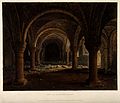St Peter-in-the-East
| St Peter-in-the-East | ||
|---|---|---|
| Parish Church of St Peter-in-the-East | ||
Style Norman, Perpendicular Gothic | | |
| Years built | 12th century | |
| Administration | ||
| Diocese | Oxford | |
St Peter-in-the-East is a 12th-century church on
History
A church has existed on the current site since the late 10th century.[2] In the 11th century, it was replaced by a stone church, which is mentioned in the Domesday Book of c. 1085:
the church of St. Peter Oxenford holds of Robert two hides in Haliwelle...It was worth twenty shillings, now it is worth forty...
The church is believed to be named after the 5th-century church of S. Pietro in Vincoli, Rome, Italy.[3] In the early 12th century the church was renamed St-Peter-in-the-East, because of its location near the East Gate of the walled city of Oxford, to differentiate it from the Church of St Peter-le-Bailey, which was built close to Oxford Castle.
The
In the twentieth century, changes in the demographics of central Oxford, mainly as a result of the First World War, led to a significant decline in the size of the congregation, and the church closed in 1965.
The present day

St Peter-in-the-East was deconsecrated in the 1970s and renovated for its present use. The building now serves as the college library of St Edmund Hall.[2]
Church building
The 12th-century church originally consisted of a crypt, chancel, and nave, extending to just beyond the south door. In the 13th century, a north aisle was added to the nave. The church tower was added in the 14th century, and the nave was either heightened or reconstructed to connect with the tower. The windows are mostly 14th-century and the door into the tower is 16th-century. At the east end of the aisle there is a small chapel dedicated to St Catharine and St Thomas, constructed in the early 16th century.
The Lady Chapel (or North Chapel) was built in the early 13th century. It was donated by
Gallery
-
The church, as seen from the Queen's Lane
-
The Church in the snow
-
A nineteenth-century drawing of the Norman crypt below St Peter-in-the-East
-
An etching of the side profile of the church, including the crypt below it
-
The Broadbent garden, around the back of the church
-
The church and the surrounding gardens
See also
- Peter du Moulin (1601–1684)
- St Peter-le-Bailey, now the chapel of St Peter's College, Oxford
References
- ^ The Library, St Edmund Hall, Oxford.
- ^ a b "St Peter-in-the-East: A Visitor's Guide". St Edmund Hall. Retrieved 21 September 2017.
- ^ The Library: St. Peter-in-the-East, St Edmund Hall, Oxford.
Further reading
- Sherwood, Jennifer; ISBN 0-14-071045-0.
External links






